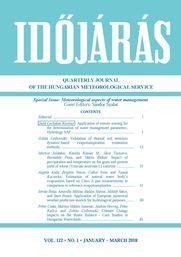IDŐJÁRÁS - angol nyelvű folyóirat
Vol. 122, No. 1 * Pages 1–99 * Januar - March 2018
 |
Special Issue: Meteorological aspects of water management |
 letöltés [pdf: 2680 KB]
letöltés [pdf: 2680 KB]
Application of remote sensing for the determination of water management parameters, Hydrology SAF
Judit Gerhátné Kerényi
DOI:10.28974/idojaras.2018.1.1 (p. 1–)
Judit Gerhátné Kerényi
DOI:10.28974/idojaras.2018.1.1 (p. 1–)
Validation of diurnal soil moisture dynamic-based evapotranspiration estimation methods
Zoltán Gribovszki
DOI:10.28974/idojaras.2018.1.2 (p. 15–)
Zoltán Gribovszki
DOI:10.28974/idojaras.2018.1.2 (p. 15–)
Impact of precipitation and temperature on the grain and protein yield of wheat (Triticum aestivum L) varieties
Márton Jolánkai, Katalin Kassai M., Ákos Tarnawa, Barnabás Pósa, and Márta Birkás
DOI:10.28974/idojaras.2018.1.3 (p. 31–)
Márton Jolánkai, Katalin Kassai M., Ákos Tarnawa, Barnabás Pósa, and Márta Birkás
DOI:10.28974/idojaras.2018.1.3 (p. 31–)
Estimation of natural water body’s evaporation based on Class A pan measurements in comparison to reference evapotranspiration
Angéla Anda, Brigitta Simon, Gábor Soós, and Tamás Kucserka
DOI:10.28974/idojaras.2018.1.4 (p. 41–)
Angéla Anda, Brigitta Simon, Gábor Soós, and Tamás Kucserka
DOI:10.28974/idojaras.2018.1.4 (p. 41–)
Application of European numerical weather prediction models for hydrological purposes
István Ihász, Amarilla Mátrai, Balázs Szintai, Mihály Szűcs, and Imre Bonta
DOI:10.28974/idojaras.2018.1.5 (p. 59–)
István Ihász, Amarilla Mátrai, Balázs Szintai, Mihály Szűcs, and Imre Bonta
DOI:10.28974/idojaras.2018.1.5 (p. 59–)
Climate change impacts on the water balance - case studies in Hungarian watersheds
Péter Csáki, Márton Miklós Szinetár, András Herceg, Péter Kalicz, and Zoltán Gribovszki
DOI:10.28974/idojaras.2018.1.6 (p. 81–)
Péter Csáki, Márton Miklós Szinetár, András Herceg, Péter Kalicz, and Zoltán Gribovszki
DOI:10.28974/idojaras.2018.1.6 (p. 81–)
IDŐJÁRÁS folyóirat

Az IDŐJÁRÁS a HungaroMet Nonprofit Zrt. negyedévenként megjelenő angol nyelvű folyóirata
Megrendelhető a journal.idojaras@met.hu címen.
A szerzőknek szánt útmutató itt olvasható.
Megrendelhető a journal.idojaras@met.hu címen.
A szerzőknek szánt útmutató itt olvasható.









